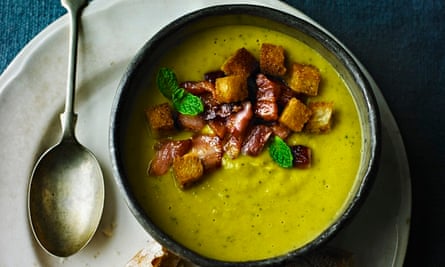My dad drove a Hackney cab when I was growing up. It was pretty cool, riding in a London taxi around Gloucester as a kid, but, thinking about it now, it was pretty eccentric. Dad was raised in south-east London – around Deptford, then Beckenham – and I suppose driving a black cab was one small way for him to stay in touch with his roots.
We went to London to visit my grandparents regularly, and even though I’d grown up in the West Country, I always had a strong connection to the Big Smoke. I felt I knew it, and the city excited me.
Early on in their careers, many chefs choose to work in France, America, or a whole host of other countries, but the only place I ever wanted to be as a young chef was London. Now, the beautiful thing about working in London kitchens is that you learn to have quick hands. The restaurant business is relentless. Mondays are as pacey as Saturdays and good restaurants never see a quiet day. You cope with the lack of sleep and you adopt a “work hard, play hard” attitude – it makes you feel alive. It’s a first-class grounding for a chef, and working there – first at the Capital hotel under Phil Britton, next at Stephen Bull’s on St Martin’s Lane with Gary Rhodes, and then at Odette’s in Primrose Hill – really set me up. In fact, the kitchen experience I had in London in my mid-20s still sits at the heart of everything we do at The Hand and Flowers – rooted in French technique, but prizing the seasonal produce of Great Britain.

When I started out, a vast majority of the best restaurants were in London. These days, the restaurant scene is less London-centric than it was, although I do notice food trends starting in the capital before taking off elsewhere in the country. Street food, all the noise about American-style barbecue such as pulled pork, the craze for “detox” stuff, it all starts in the big city – which makes sense; it’s an urban centre – more people, more media and so on. Even food and drink that doesn’t originate in London – I’m talking foraged ingredients, microbreweries and craft distilleries – has all been made noteworthy there.
When I think about the food I most associate with London, however, it isn’t trends that spring to mind at all. For me, London is all about –tradition, the unfashionable stuff that makes me feel like an old-school British chef: hotel dining rooms, afternoon tea at the Ritz and, on the other end of the spectrum, hearty, economical stews put together cheaply to feed the smoggy capital’s masses in Victorian times. So the recipes in my last column before Christmas ignore all the modern diversity in London’s restaurant scene and are proudly grounded in tradition – both in the choice of ingredients and the dishes themselves.
The London Particular is a wholesome, wintry soup developed in the early 20th century. It gets its curious name from the coal-smoke smog (imagine it: thick, yellow, grim – like “pea soup”!) which was particular to – you guessed it – London. It contains boiled split peas (perhaps the dry pulse that people least associate with other cuisines), bacon and meat stock – a trio of ingredients I’m fond of using in the restaurant – cut through with herbs and the much underrated malt vinegar, which lends a dark acidity to an otherwise rich concoction. .
Talking of curious names, “mincemeat” is a strange word for a sweet and fruit-based substance, isn’t it? The thing is, mincemeat was originally made with fruit, spices and – yes – meat, which was only excluded from the recipe last century. Once again, I’ve gone down a traditional route with my sweetmeat mince pies – loaded with raisins and Christmas spices such as cinnamon, and combining these with pork meat, to make a pie reminiscent of North African flavours.
To finish off, I’ve given you a junket. Another good name! Junkets are set, milk-based puddings – a bit like a thin pannacotta – and I’ve replaced the traditional rum in this recipe with London dry gin and a good kick of juniper.
It’s been fun to give some of my favourite meals – soups, pies, puds – a London twist. And it came surprisingly naturally to me. Maybe these dishes are my link to the capital, my black cab in Gloucester!
London particular
Named after London’s Victorian “pea soup” fog, this is a beautiful blend of pulse and pork. And it makes a nice change from Christmas food.

Serves 4-6
100g butter
250g bacon lardons
1 onion, diced
2 sticks celery, diced
1 carrot, diced
50g caster sugar
100ml malt vinegar
200g dry split peas
1.25-1.5 litres chicken/ham stock
1 bunch rosemary tied together
2 bay leaves
2 handfuls mint leaves, save some to garnish
2 tbsp creme fraiche
Croutons, to garnish
1 Heat up a large saucepan and melt the butter. Add the bacon and fry until browned and crispy, then remove from the pan and drain on kitchen paper.
2 Add the diced vegetables to the saucepan and cook in the bacon fat and butter until soft. Add the caster sugar, then the malt vinegar. Bring to the boil and reduce until the vinegar has completely evaporated.
3 Add the split peas, then cover with the ham or chicken stock. Bring to the boil. Turn it down to a simmer, then add the rosemary and bay leaves. Cook gently for 45-50 minutes, until the peas are soft and cooked. Remove from the heat and take out the rosemary and bay leaves.
4 Blend the soup in a jug blender with the mint leaves and creme fraiche until smooth. Season and pass through a fine sieve. Serve with the crispy bacon, croutons and a few mint leaves. Drizzle on a little malt vinegar if you fancy.
Gin junket
This is an old English classic and very simple to make. I like to serve this with macaroons to give a little texture and depth to the occasion. You can buy rennet at chemist shops.

Serves 4
600ml whole milk
50g sugar
1 tsp rennet
or 3 gelatin leaves
10ml gin
2 tsp ground toasted juniper
1 Bring the milk and sugar to 37C/98F and pour in the rennet and gin. Pass through a fine sieve into your 4 serving bowls. Leave to set at room temperature; this will take about an hour. Sprinkle the ground juniper over the top, put into the fridge for 45 minutes, then serve.
Sweet meat ‘mince pies’ with raisins and rice
A little bit like Christmas mince pies, but with proper meat in them. Another name for these could be North African pork pies – then you can eat them any time of the year!

Makes 20-24 miniature pies or 1 x 22cm-diameter pie
For the pastry
350g plain flour
200g diced cold butter
1 large beaten egg
1-2 tbsp cold water
For the pie filling
600g minced pork
Oil for cooking
1 diced onion
2 garlic cloves, grated
4 tsp ground cinnamon
4 tsp ground cumin
2 tsp turmeric
1 tbsp icing sugar
2 tsp ground chilli powder
150g raisins
150g cooked plain rice
250ml brown chicken stock
2 tbsp ground almonds
Salt and black pepper, to taste
For the topping
1 tbsp ground cinnamon
1 tbsp caster sugar
1 tsp flaky sea salt
1 To make the pastry, rub together the flour and the butter. Bring it together to a breadcrumb consistency. Add the beaten egg and the cold water, then bring the mix together to form a dough. Remove the dough from the bowl and turn out on to a clean surface, then knead it like you would for a bread. Keep working it until it forms a smooth pastry. Wrap the pastry with clingfilm and put it in the fridge to rest for at least 1 hour. Preheat the oven to 200C/400F/gas mark 6.
2 To make the pork filling, rinse the minced pork in a colander under running cold water. Separate it all into small pieces. Drain it, then transfer it to a roasting tray. Put it in the oven and bake for 25-30 minutes until crispy, browned and dry. Make sure you stir every 5-10 minutes to ensure that you get even cooking. When cooked, remove from the oven and drain in a colander. Leave to cool. Turn the oven down to 180C/350F/gas mark 4
3 Pour a drizzle of oil into a large saucepan and heat it over a medium heat. Add the diced onion and the grated garlic and sweat down until soft.
4 Stir in the ground cinnamon, cumin, turmeric, icing sugar and chilli powder. Cook this spice mix for a further 3‑4 minutes and then add the drained pork mince to the pan. Add the raisins and the cooked rice.
5 Pour on the brown chicken stock and bring to the boil. Add the ground almonds and stir. Reduce the heat to a simmer and slowly reduce to a thick filling. Season and put aside to cool.
6 On a lightly floured surface, roll out ⅔ of the pastry to 3mm – no thinner. Cut circles out to line the smaller tart moulds or line a 22cm-diameter pie tin. Spoon in the pork mix generously. Roll the final ⅓ of the pastry to use as lid(s). Trim the edges and seal with a fork.
7 Brush the top with some water and mix together the ground cinnamon, caster sugar and flaky sea salt. Sprinkle on top of the pie and bake in the oven for 40-45 minutes, or until the pastry is golden brown and cooked all the way through. Leave to cool for 10 minutes before serving. This will keep cold for a couple of days.

Comments (…)
Sign in or create your Guardian account to join the discussion